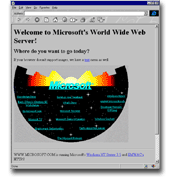A corporate website has come a long way in terms of its utility and its overall perception to the stakeholders. Today corporate websites not only provides comprehensive information about the company but also play an important role in executing its business and sales models. What better an example to illustrate this point than Microsoft.com?
Phase I: Only Corporate Strategy, No Internet Strategy
When Microsoft got started on the web, it was a laggard of sorts, way behind Netscape.
Experts all over conceded that it took a while for Microsoft to figure out the Internet, and when it did, all it knew that it had to become No.1 in the browser market. So, its web presence was an extension of its corporate strategy—Go after Netscape.
Microsoft.com in the initial years reflects this strategy where all its new versions had only one purpose; showcase the features of Internet Explorer and make it easy for internet users to get and start using it. The period between 1996-1998 saw the website changing from a simple-gray-background-some-pages to a information-rich-yet-showcasing-the-new-features-IE (active X controls etc).
Phase II: In comes an Internet Strategy
Only when Microsoft’s IE made significant inroads into Netscape’s market, did it start asking the question “What should I do with Internet today?”
When it did, the ‘user’ took center stage and an internet strategy came to fore. Microsoft.com transformed into a site that does lot of things for the user than just be a showcase site for its products. Suddenly all the other components fell in place like that of MSDN, Support etc. The homepage not just informed the users but guided them to action.
Significantly, two things happened. One, the site became more user-friendly. Second, there was something for the users to do on the site as a part of their daily routine.
Suddenly the interest in Microsoft.com went up and the users grew exponentially.The period between the later half of the year 1998 to the year 2003, saw Micrsoft.com emerge as one of the world’s top visited sites in the world. Interestingly this also allowed the company to tout the capability of its Windows Server line of products, driving home the point—’If it is good for Micrsoft.com it is good enough for you’.
Phase III: Internet Strategy aligns with the Corporate Strategy.
Somewhere in the year 2003, Microsoft’s plans in the consumer products division started yielding results. Leading the pack was X-Box, a playstation rival. Since then, the website’s design reflects a certain enthusiasm, almost child like. It continues till date with over half of the home page real estate devoted to new consumer products. Every now and then, when Mr.Gates unveils new products at events like Comdex, the homepage is agog with such news.
The homepage is now a place of action with vibrant color images of games and gadgets. While the corporate strategy is dictating such design changes, its Internet strategy, which is centered on understanding and engaging the customer is intact.
Internet today plays an important role in Microsoft’s sales model and with its latest offering ‘Zune’ it might even be a part of its business model.
You might never know, if Microsoft.com becomes synonymous with the company or LIVE becomes the only way it would deliver its products. However, two things appear to be certain. One, its components of Internet strategy—Excite, Inform and Prompt to action—are here to stay. Two, Internet strategy is a part of its corporate strategy now.
Next article in this series: Apple’s Internet journey
Related links
A brief history of Microsoft on the web


